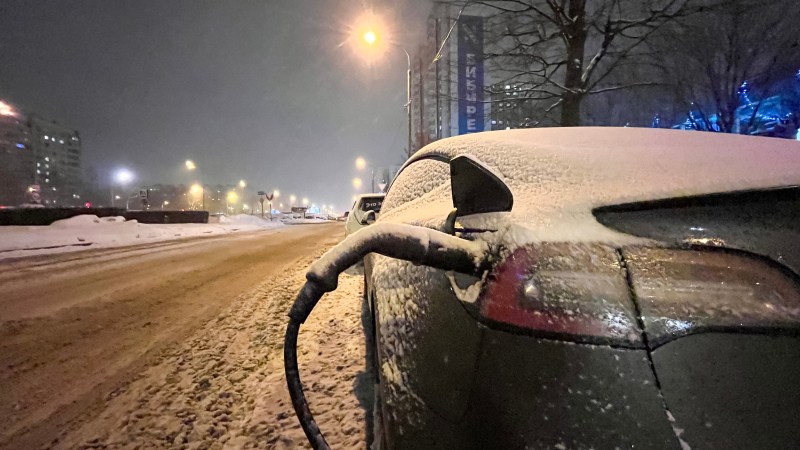
Tesla Cybertruck snow performance isn’t the only climate-related EV problem. Frigid Arctic temperatures caused havoc among Chicago-area EV owners in mid-January. During extended hours of sub-zero temperatures, EV batteries couldn’t hold their charge, and charging took much longer than usual. Charging times grew, and waiting times multiplied at charger locations overwhelmed by the weather.
TV news pieces showed Tesla supercharger stations with long lines of cars waiting to charge and people pushing Teslas with depleted batteries to parking spaces. Tesla is an easy target, but the very low temperatures affect all EVs with Lithium-ion batteries.

Why climate change matters with EVs
Many people equate climate change with global warming, but the changes aren’t that simple. For example, record-breaking cold waves dipping into the midwestern U.S. and causing significant power outages in Texas during the past few years illustrate the complex global interplay of temperature and wind. Temperatures in the Arctic Circle are increasing, shifting the polar vortex with accompanying winds that blow and hold the frigid air much further south than usual. The nine-day historical deep freeze extended to the entire state of Texas in February 2021 was a wake-up call for many people about climate change.
Lithium-ion batteries don’t fare well during lengthy, profound freeze events. The electrochemical properties that make them popular for powering everything from earbuds to electric vehicles make them particularly susceptible to very low temperatures.
Tesla owner’s manuals have extensive sections on operating the vehicle climate controls, with separate sections for Cold Weather Best Practices and Hot Weather Best Practices.
When the temperatures drop below zero degrees Fahrenheit, Lithium-ion batteries lose capacity and do not charge efficiently. Researchers worldwide are working on new battery technologies while others are exploring ways to modify Lithium-ion battery components, additives, and coatings that can mitigate the effect of brutal cold on Lithium-ion batteries in EVs.

Preconditioning EVs for extreme temperatures
The same batteries power EV drivetrains and run the vehicle’s heating and cooling systems. Getting into a very hot or cold car and cranking up the heat or AC at the start of a trip is a hefty drain on the battery. Therefore, most EVs have a preconditioning capability.
Preconditioning prepares the vehicle for a trip by warming the battery to the best temperature for efficient driving and, at the same time, gradually pre-cooling or pre-heating the interior. Preconditioning uses much less energy than hopping in and jacking the temperature up or down when you pull out of a garage or parking space. EV owners learn to appreciate getting into preconditioned cars because of the comfort, but preconditioning can also avoid unnecessarily diminishing driving range.
Preconditioning doesn’t change the electrochemistry of Lithium-ion batteries. Still, it can conserve battery power by preparing the battery before starting a trip so that it operates in the most efficient manner possible. Leaving home with a warmed battery and a warm vehicle interior is the best practice when the temperatures outside are frigid.

Tesla cold weather best practices
Tesla owner’s manuals have extensive sections on operating the vehicle climate controls, with separate sections for Cold Weather Best Practices and Hot Weather Best Practices. In the cold weather section, the Tesla Model 3 owner’s manual includes instructions and suggestions for preconditioning by warming the cabin and battery, manually releasing a frozen charge port latch, and charging. Tesla generally recommends allowing 30 to 45 minutes before starting a trip or before arriving at a charging station while traveling to precondition the car and its systems.
The same section also includes tips on clearing snow, ice, and frost from the windshield, windows, and mirrors. Because doors and door handles can freeze, the manual also has suggestions with helpful graphics that show how best to open or unstick a door without during yourself or the vehicle. Additional valuable tips in the Tesla manual include turning off the auto-fold function for side mirrors so unfolding isn’t a problem with a coating of ice. Telsa suggests putting the windshield wipers in service mode so defrosting the windshield will also defrost the wipers.
Tesla also advises that freezing temperatures can interfere with regenerative braking until the car battery warms up sufficiently, which is another reason to precondition your car.

Home charging is one of the best cold-weather practices
Many Chicago-area Tesla owners stuck waiting in long lines of battery-depleted EVs in January might have avoided the significant impacts of the cold snap by charging at home. In Tesla’s first years of sales, Supercharging for life for free was an attractive enticement. If Tesla owners assume that public charging is better and don’t install Level 2 home chargers, they may want to rethink that decision as winters get colder. Home charging often isn’t a viable option for apartment dwellers, but the ability to charge your EV in a time-and-cost-efficient manner could be the best cold-weather practice for your comfort and vehicle health.



